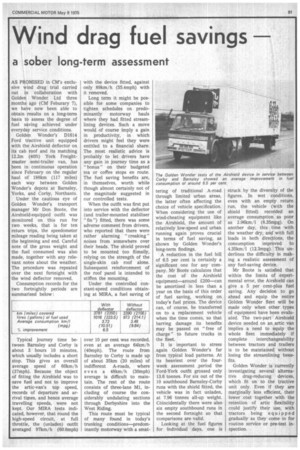Wind drag fuel savings
Page 51

If you've noticed an error in this article please click here to report it so we can fix it.
a sober long-term assessment
AS PROMISED in CM's exclusive wind drag trial carried out in collaboration with Golden Wonder Ltd three months ago (CM Feburary 7), we have now been able to obtain results on a long-term basis to assess the degree of fuel saving achieved under everyday service conditions.
Golden Wonder's DI614 Ford tractive unit equipped with the Airshield deflector on its cab roof and its matching 12.2m (401t) York Freightmaster semi-trailer van, has been in continuous operation since February on the regular haul of 188km (117 miles) each way between Golden Wonder's depots at Barnsley, Yorks, and Corby, Northants.
Under the cautious eye of Golden Wonder's transport manager Mr Don Boote, the Airshield-equipped outfit was monitored on this run for two weeks, that is for ten return trips, the speedometer mileage reading being taken at the beginning and end. Careful note of the gross weight and the fuel consumed was also made, together with any relevant notes about the weather. The procedure was repeated over the next fortnight with the wind deflector removed.
Consumption records for the two fortnightly periods are summarised below: Typical journey time between Barnsley and Corby is about 3 hours 10 minutes, which usually includes a short stop. This gives an overall average speed of 60km/h (37mph). Because the object of fitting the Airshield was to save fuel and not to improve the artic-van's top speed, records of departure and arrival times, and hence average travelling speeds, were not kept. Our MIRA tests indicated, however, that round the high-speed circuit, at full throttle, the (unladen) outfit averaged 97km/h (60.8mph) with the device fitted, against only 89km/h (55.4mph) with it removed.
Long term it might be possible for some companies to tighten schedules on predominantly motorway hauls where they had fitted streamlining devices. Such a move would of course imply a gain in productivity, in which drivers might feel they were entitled to a financial share. The most realistic advice is probably to let drivers have any gain in journey time as a " bonus" on their budgeted tea or coffee stops en route. The fuel saving benefits are, in themselves, worth while though almost certainly not of the magnitude suggested in our controlled tests.
When the outfit was first put into service with the deflector (and trailer-mounted stabiliser "fin") fitted, there was some adverse comment from drivers, who reported that there were rather alarming "creaking" noises from somewhere over their heads. The shield proved to be mounted too flimsily, relying on the strength of the single-skin cab roof alone. Subsequent reinforcement of the roof panel is intended to stiffen the mounting.
Under the controlled constant-speed conditions obtaining at MIRA, a fuel saving of over 10 per cent was recorded, even at an average 64km/h (40mph). The route from Barnsley to Corby is made up of about 35km (20 miles) of indifferent A-roads, where even a 48km/h (30mph) average is difficult to maintain. The rest of the route consists of three-lane MI, including of course the considerably undulating sections through Derbyshire into the West Riding.
This route must be typical of many found in today's trunking conditions—predominantly motorway with a smat tering of traditional A-road through limited urban areas, the latter often affecting the choice of vehicle specification. When considering the use of wind-cheating equipment like the Airshield, the amount of relatiVely low-speed and urban running again proves crucial in terms of fuel saving, as shown by Golden Wonder's long-term findings.
A reduction in the fuel bill of 6.5 per cent is certainly a significant one for any company. Mr Boote calculates that the cost of the Airshield equipment—around £200—can be amortised in less than a year on the basis of this order of fuel saving, working on today's fuel prices. The device can, of course, be transferred on to a replacement vehicle when the time comes, so that barring damage its benefits may be passed on "free of charge" to future trucks in the fleet.
It is important to stress again Golden Wonder's far from typical load patterns. At its heaviest over the fourweek assessment ...period the Ford-York outfit grossed only 13.6 tonnes. For six out of the 10 southbound Barnsley-Corby runs with the shield fitted, the vehicle was in fact unladen, at 7.96 tonnes all-up weight. Coincidentally there were also six empty southbound runs in the second fortnight so that comparisons are valid.
Looking at the fuel figures for individual days, one is struck by the diversity of the figures. In wet conditions, even with an empty return run, the vehicle (with the shield fitted) recorded an average consumption as poor as 2.96km/I (8.35mpg). On another day, this time with the weather dry, and with full loads in both directions, the consumption improved to 4.35krn/1 (12.3mpg). This underlines the difficulty in making a realistic assessment of any fuel-saving device.
Mr Boote is satisfied that within the limits of experimental error, the Airshield can give a 5 per cent-plus fuel saving. Any decision to go ahead and equip the entire Golden Wonder fleet will be made only when other types of equipment have been evaluated. The two-part Airshield device needed on an artic van implies a need to equip the whole fleet immediately if complete interchangeability between tractors and trailers is to be maintained without losing the streamlining benefits.
Golden Wonder is currently investigating several alternative drag-reducing devices, which fit on to the tractive unit only. Even if they are marginally less efficient, their lower cost together with the retention of artic flexibility could justify their use, with tractors being equipped gradually as they come in for routine service or pre-test inspection.




























































































































































